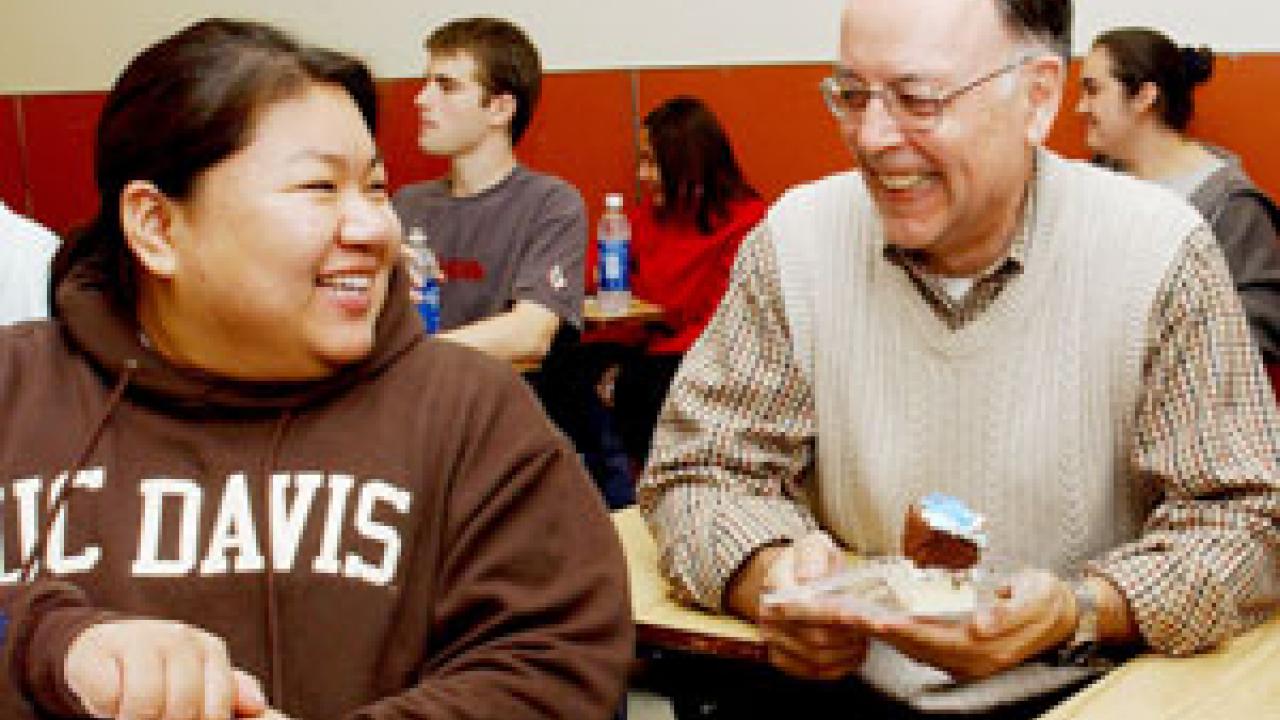Francisco Samaniego, professor of statistics at UC Davis, loves his subject and he loves a challenge. When part of your job includes teaching a required introductory class in statistics, that might be just as well. Now his passion for his subject has earned Samaniego UC Davis' top prize.
The $30,000 UC Davis Prize for Undergraduate Teaching and Scholarly Achievement, funded by the UC Davis Foundation, is believed to be the largest of its kind in the United States.
"This prize honors UC Davis faculty who combine extraordinary scholarship with outstanding undergraduate teaching, and Professor Samaniego certainly exemplifies these qualities," said Chancellor Larry Vanderhoef.
"He is internationally recognized for his research on statistics, and he combines his scholarly excellence with a creative and dedicated approach to teaching," Vanderhoef said.
Michael Sugawara, vice chairman of the UC Davis Foundation, also offered his congratualations, noting, "The trustees feel that this award is one of the best ways to express our pride in UC Davis and its wonderful faculty."
Samaniego has devoted 32 years, more than half his life, to teaching excellence at UC Davis, said Winston Ko, dean of the division of mathematical and physical sciences. " He is held in high esteem in his research field, which reaches all parts of the university, and his students are inspired by his exemplary teaching methods. In teaching, research and service, he is a model for us all," Ko said.
"Exceptional!!!" "A great class," "The best teacher I've had at any level," are some comments from recent student evaluations of Samaniego's teaching. Students who describe themselves as intimidated or even scared of statistics before taking his classes say they've learned to understand and even enjoy the subject.
"When I meet people who freeze up at the mention of the subject, it's usually because they weren't introduced to it properly," Samaniego said.
Samaniego said he loves the way statistics interfaces with virtually all other disciplines, from engineering to genetics and sociology to medicine. Statistics provides you with limitless opportunities to learn about and contribute to solving practical problems of all types, he said. On the mathematical side, the puzzles and surprises that you encounter in the theory and application of probability and statistics can't help but draw you in, he said.
"I like to bring these perspectives into the classroom, teaching both the why and how of my subject and trying to help students experience both the beauty and the utility of probability and statistics," Samaniego said.
In his research, Samaniego has focused on Reliability Theory, used for example in engineering to study how systems perform over time. He has also made important contributions to the controversial area of Bayesian statistics. Bayesian methods differ from "classical" statistics in allowing for a certain amount of intuition in the analysis of experimental data. Samaniego has published a theorem that characterizes situations in which Bayesian methods perform better than classical approaches. "Unless Bayesians are both misguided and stubborn, they are likely to do better at estimating an unknown quantity than a classical statistician," he said.
As director of the UC Davis Statistical Laboratory in the early 1980s and again from 1998 to the present, Samaniego has worked with other researchers on a wide variety of applied projects including dam design, traffic congestion, plant genetics, the economics of recycling and the assessment of school quality. He often uses real-world examples in the classroom, encouraging students to think about how they would approach a problem.
Samaniego admits he's a demanding teacher who pushes students to their limits. "It's when people stretch that they can reap the greatest rewards," he said.
But that also means you have to be there to support the students when they are stuck, worried or discouraged, he said. He makes extensive use of office hours and e-mail to keep in touch with his class. "I keep pushing and supporting and pushing and supporting. I learned early on that neither accomplishes much without an equal dose of the other," he said.
For Samaniego, each level of teaching brings its own rewards. With large classes of freshmen, it's the challenge of getting them to see the value of the subject. Samaniego cites one past student in a lower division class. The first in her family to attend college, she was drifting from one major to another, but found a foothold in Samaniego's classroom. She eventually majored in the subject and now holds a doctorate in biostatistics from Harvard. "I burst with pride every time I think about her," he said.
In upper division classes, students already know they need statistics, but often haven't really understood the subject or appreciated its beauty. And graduate students are more like colleagues, sharing in the discovery process. "At this level, I think they push me as much as I push them, and the experience is good for all of us," Samaniego said.
Samaniego received a bachelor's degree in mathematics from Loyola University, a master's from Ohio State University and his doctorate from UCLA. He did postdoctoral work at Florida State University before joining the statistics faculty at UC Davis in 1972. He spent the year 1982-83 at the University of Washington as a Ford Foundation fellow.
At UC Davis, he has served as assistant vice chancellor for academic affairs, director of the Teaching Resources Center, and director of the Statistical Laboratory, the consulting arm of the Department of Statistics.
As director of the TRC from 1992 to 1998, revamping the training of teaching assistants and promoting computer-based learning methods.
He currently serves as editor of the "Theory and Methods" section of the Journal of the American Statistical Association, one of the world's top scholarly journals in statistics.
He is a fellow of the American Statistical Association, the Royal Statistical Society and the Institute of Mathematical Statistics, and an elected member of the International Statistical Institute.
